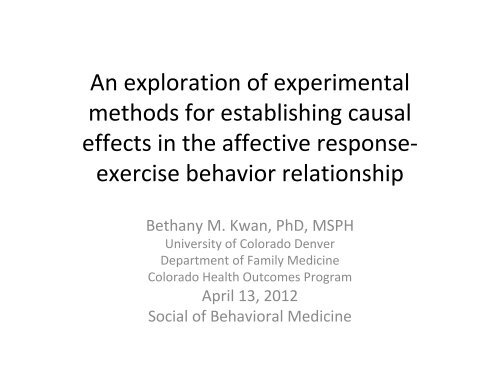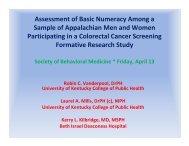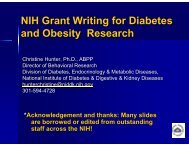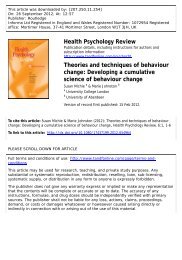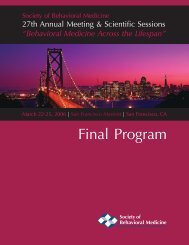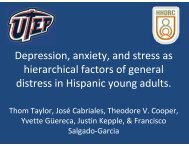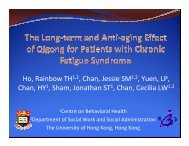An Exploration of Experimental Methods for Establishing Causal ...
An Exploration of Experimental Methods for Establishing Causal ...
An Exploration of Experimental Methods for Establishing Causal ...
Create successful ePaper yourself
Turn your PDF publications into a flip-book with our unique Google optimized e-Paper software.
<strong>An</strong> exploration <strong>of</strong> experimental<br />
methods <strong>for</strong> establishing causal<br />
effects in the affective responseexercise<br />
behavior relationship<br />
Bethany M. Kwan, PhD, MSPH<br />
University <strong>of</strong> Colorado Denver<br />
Department <strong>of</strong> Family Medicine<br />
Colorado Health Outcomes Program<br />
April 13, 2012<br />
Social <strong>of</strong> Behavioral Medicine
Affective Response to Exercise<br />
• Affect ratings be<strong>for</strong>e,<br />
during, and 5 mins after a<br />
20-minute bout <strong>of</strong> treadmill<br />
exercise at 90-100% <strong>of</strong><br />
heart rate at ventilatory<br />
threshold<br />
• Feeling Scale (feel<br />
good/bad, -5 to +5)<br />
• Felt Arousal Scale (low/high<br />
arousal, 1 to 6)<br />
• Reed & Ones, 2006 metaanalysis<br />
– increases in<br />
positive-activated affect,<br />
but moderators exist<br />
Kwan, 2010
Affective response and<br />
future exercise behavior<br />
• Modest associations with future behavior<br />
– Wiliams et al., 2008; Kwan & Bryan, 2010a;<br />
Schneider et al., 2009<br />
• Effects on motivational factors<br />
– Intentions, self-efficacy, attitudes (Kwan & Bryan,<br />
2010b)<br />
– Intrinsic/self-determined motivation (Schneider &<br />
Kwan, in press; Kwan, Magnan, Caldwell Hooper,<br />
& Bryan, 2011)
<strong>Causal</strong> Inference<br />
• Measurement<br />
– Affect and behavior<br />
• Manipulation<br />
• Confounding<br />
• Mechanisms<br />
• Design <strong>of</strong> interventions
Manipulations/Interventions<br />
• Exercise stimulus<br />
– Intensity (Ekkekakis, Hall, & Petruzzello, 2008)<br />
• Cognition<br />
– Attentional Association and Dissociation (Lind, Welch, &<br />
Ekkekakis, 2009)<br />
– Self-efficacy (Jerome et al., 2002)<br />
• Social and Physical Environment<br />
– Psychological Need Satisfaction (Edmunds, Ntoumanis, &<br />
Duda, 2008)<br />
– Setting (outdoors vs lab; Focht, 2009)<br />
– Music (Brownley, McMurray, & Hackney, 1995); loudness<br />
and tempo (Edworthy & Waring, 2006)
The Problem<br />
• These are not (only) affect<br />
• Independently influence exercise behavior<br />
• Laboratory manipulations and non-laboratory<br />
exercise<br />
• Fleeting effects<br />
Affective<br />
Response<br />
Self-Efficacy<br />
Behavior
Manipulating affect (and only affect)<br />
• Is this possible?<br />
• Innovative intervention approaches?<br />
– Mindfulness, emotion regulation training<br />
– Dialectical Behavior Therapy (Linehan, 1993) –<br />
managing intense negative emotion
Affect/Emotion<br />
• Automatic affect<br />
– Arising quickly, automatically in response to an acute<br />
stimulus<br />
– Corresponding rapid physiological response<br />
– More basic (good/bad)<br />
– Effects on less conscious, automatic behavior<br />
• Emotion<br />
– Arising more slowly, <strong>of</strong>ten as a result <strong>of</strong> analysis <strong>of</strong><br />
meaning in the context <strong>of</strong> one’s goals and values<br />
– More complex, self-relevant<br />
– Effects on conscious, planned behavior<br />
• Operationalization, measurement issues<br />
Gross, 2002; Baumeister et al., 2007
Vigorous Exercise?<br />
• Exercise recommendations and intensity<br />
– Weight loss<br />
– Conditioning<br />
• Preference<br />
• Discom<strong>for</strong>t and negative affect<br />
• Distress tolerance
Emotion Regulation<br />
• Emotion regulation<br />
– “The processes by which we influence which emotions<br />
we have, when we have them, and how we<br />
experience and express them.” Gross, 1998; 2002<br />
– Down-regulation <strong>of</strong> (negative) emotion to decrease<br />
impact (on thoughts, behavior)<br />
– Up-regulation <strong>of</strong> (positive) emotion to increase impact<br />
• <strong>An</strong>tecedent-focused emotion regulation<br />
strategies<br />
• Response-focused emotion regulation strategies
Emotion regulation strategies<br />
(Gross, 2002)<br />
• Emotion can be regulated at multiple points in<br />
the process <strong>of</strong> the generation <strong>of</strong> emotion and<br />
associated response tendencies<br />
– Situation selection<br />
– Situation modification<br />
– Attentional deployment<br />
– Cognitive change (reappraisal)<br />
– Response modulation (suppression)
Cognitive Reappraisal<br />
• “The personal meaning that is assigned to the situation<br />
is crucial because it powerfully influences which<br />
experiential, behavioral, and physiological response<br />
tendencies will be generated in that particular<br />
situation” (Gross, 2002, pg. 282)<br />
– Can magnify or decrease intensity <strong>of</strong> emotion, or change<br />
the emotion itself<br />
• Appraisals related to physiological state, perceived<br />
ability and control, attentional focus and expected<br />
outcomes identified as themes pertaining to the<br />
affective response to exercise in high-active and lowactive<br />
women (Rose & Parfitt, 2010)
Mindfulness<br />
• Definition<br />
– “The cultivation <strong>of</strong> concentration, attention, and<br />
non-judging acceptance towards whatever one is<br />
experiencing in the present moment” (Bishop et<br />
al., 2004)
Mindfulness and Emotion Regulation<br />
• Emotion regulation<br />
– Avoidance <strong>of</strong> negative experience not always adaptive<br />
• Mindfulness can serve as emotion regulation (Hayes &<br />
Feldman, 2004)<br />
– Lower levels <strong>of</strong> intensity and frequency <strong>of</strong> unpleasant<br />
affect <strong>for</strong> those high in trait mindfulness (Brown & Ryan,<br />
2003)<br />
– Increased willingness to tolerate<br />
uncom<strong>for</strong>table emotions and sensations (Eifert & Heffner,<br />
2003; Levitt, Brown, Orsillo, & Barlow, 2004)<br />
• Pain sensitivity<br />
– Lower pain sensitivity and increased analgesic effects<br />
during mindful states (Grant & Rainville, 2008)
“Leaves on a stream”<br />
Haynes et al., 1999
Mindfulness induction<br />
• 15-min “mindfulness induction”<br />
– Focused breathing using ongoing mindfulness <strong>of</strong><br />
breath instructions (Arch & Craske, 2006)<br />
– Compared to the effects <strong>of</strong> unfocused attention and<br />
worrying<br />
• Response to picture slides from the International<br />
Affective Picture System<br />
– Affect Scale (Wolpe, 1990): -50 to +50<br />
– PANAS (Mackinnon et al. ,1990): positive and negative<br />
affect subscales<br />
• Increased willingness to view optional block <strong>of</strong><br />
highly negative stimuli
Mindfulness and Exercise<br />
• Pilot study <strong>of</strong> 8-week mindfulness-based<br />
stress reduction (MBSR) training <strong>for</strong> women<br />
with heart disease (Robert McComb, Tacon,<br />
Randolph, & Caldera, 2004)<br />
– Submaximal exercise responses<br />
• Mindfulness and the intention-behavior<br />
relationship <strong>for</strong> exercise (Chatzisarantis &<br />
Hagger, 2007)
Goals<br />
• Affect arises in response to discrepancies in<br />
actual-desired goal states (Higgins), appraisals<br />
<strong>of</strong> rate <strong>of</strong> progress in pursuit <strong>of</strong> goals (Carver).<br />
• Acute bouts <strong>of</strong> exercise: part <strong>of</strong> discrepancyreducing<br />
feedback loop<br />
– Exercise part <strong>of</strong> behavioral schema, used to<br />
regulate affect (c.f., Baumeister, Vohs, DeWall, &<br />
Zhang, 2007)
Enhancing associations between affect<br />
and behavior<br />
• Can we explicitly link behavior to affect, such<br />
that negative affect (stress, anxiety, sadness) in<br />
our daily lives cues physical activity?<br />
• Intervention: conscious awareness <strong>of</strong> association<br />
between behavior and affective response<br />
– Implementation intentions: negative affect as cue to<br />
behavior (more automatic over time)<br />
• This is somewhat different from saying that<br />
people should choose exercise that they enjoy<br />
– Positive affective response distinct from<br />
fun/enjoyment (Raedeke, 2007)
Summary<br />
• Innovative physical activity interventions may<br />
include components designed to improve the<br />
affective response to exercise<br />
– Vigorous exercise<br />
• <strong>Causal</strong> effects are not well understood<br />
– Difficulty manipulating the affective response to<br />
exercise (beyond intensity, self-efficacy)<br />
• Emotion regulation, mindfulness, and affective<br />
cues<br />
– Dialectical Behavior Therapy (DBT) exercises?


